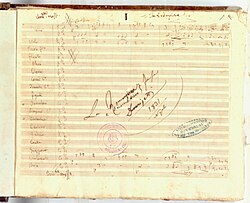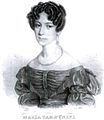La romanzesca e l'uomo nero
| Work data | |
|---|---|
| Title: | La romanzesca e l'uomo nero |

Title page of the autograph |
|
| Shape: | Opera buffa in one act |
| Original language: | Italian |
| Music: | Gaetano Donizetti |
| Libretto : | Domenico Gilardoni |
| Premiere: | June 18, 1831 |
| Place of premiere: | Teatro del Fondo , Naples |
| Playing time: | approx. 1 ½ hours |
| Place and time of the action: | Count's palazzo |
| people | |
|
|
La romanzesca e l'uomo nero (also La romanziera e l'uomo nero ; German: "The romantic woman and the black man") is an opera buffa in one act by Gaetano Donizetti . The libretto written Domenico Gilardoni . The premiere took place on June 18, 1831 at the Teatro del Fondo in Naples.
Plot (reconstructed)
The count has just returned from a long trip with his friend Baron Tommaso Ruperti. The two men want to strengthen their friendship by connecting their families: Antonia, the count's only daughter, is to marry Carlino, the baron's son. During the Count's absence the governess Trappolina was to take care of Antonia's education, and Chiarina, an orphaned niece, was brought into the house to join her.
Antonia is filled with the romantic stories that she finds in her father's library. Depressed by the thought of having to marry young Carlino according to her father's will, she vacillates between the fulfillment of duty and romantic ideas of true love. The head of house Tommaso has also smuggled his nephew Filidoro into the house, who goes by the name of “l'uomo nero” and ingratiates himself with Antonia as a mysterious, black figure.
Carlino, a frequent guest in the house, feels more drawn to Chiarina than his future fiancé Antonia and is appalled when he learns that the marriage is due to take place the next day. Antonia, who replies Carlino's dislike, seeks help from the black man Filidoro. Both decide to escape paternal tyranny. Antonina would like to give up the worldly life and lead a simple but romantic life in the woods. After numerous complications, the count ends the two lovers' escape and recognizes the black man as his hairdresser Filidoro. Suddenly torn out of her romantic dreams, Antonia realizes her mistake ("Mai più romanticismo! - No more romance!"). Who will marry whom in the end remains open.
layout
The work is an "opera of the new brevity" and contains concentrated the classic forms of bel canto with cavatina and cabaletta . Originally, the music numbers were linked by prose dialogues, but these were lost. The premiere attracted little attention and after only one further performance the piece was canceled again. La romanzesca e l'uomo nero was the second opera, alongside Francesca di Foix , that Donizetti wrote in 1831.
Work history
Luigia Boccabadati (Antonina), Anna Manzi-Salvetti (Trappolina), Marietta Gioja-Tamburini (Chiarina), Antonio Tamburini (Carlino), Francesco Salvetti (Fedele), Gennaro sang at the premiere on June 18, 1831 at the Teatro del Fondo in Naples Ambrosini (Il conte), Lorenzo Lombardi (Filidoro), Gennarino Luzio (Tommaso) and Tauro (Giappone).
Luigia Boccabadati ,
the first Antonia
Discography
- 2000, David Parry : Elisabetta Scano, Adriana Cicogna, Bruce Ford , Paul Austin Kelly, Pietro Spagnoli
Academy of St Martin in the Fields . Audio CD Opera Rara - 2000, Franco Piva: Patrizia Cigna, Claudia Marchi, Giovanni Gregnanin, Patrizio Saudelli, Alessandro Calamai,
Orchestra Filarmonica Veneta "GF Malipiero"
literature
- Robert Steiner-Isenmann: Gaetano Donizetti. His life and his operas. Hallwag, Bern 1982. ISBN 3-444-10272-0 ; P. 132; 505
- Jeremy Commons: Booklet on the Opera, Opera Rara , 2000
Web links
- La romanziera e l'uomo nero : Sheet music and audio files in the International Music Score Library Project
- La romanziera e l'uomo nero (Gaetano Donizetti) in the Corago information system of the University of Bologna
- Discography of La romanzesca [romanziera] e l'uomo nero at Operadis
Individual evidence
- ↑ June 18, 1831: “La romanzesca”. In: L'Almanacco di Gherardo Casaglia ., Accessed on August 8, 2019.
- ↑ network information on operone.de ( Memento of 4 March 2016 Internet Archive )



